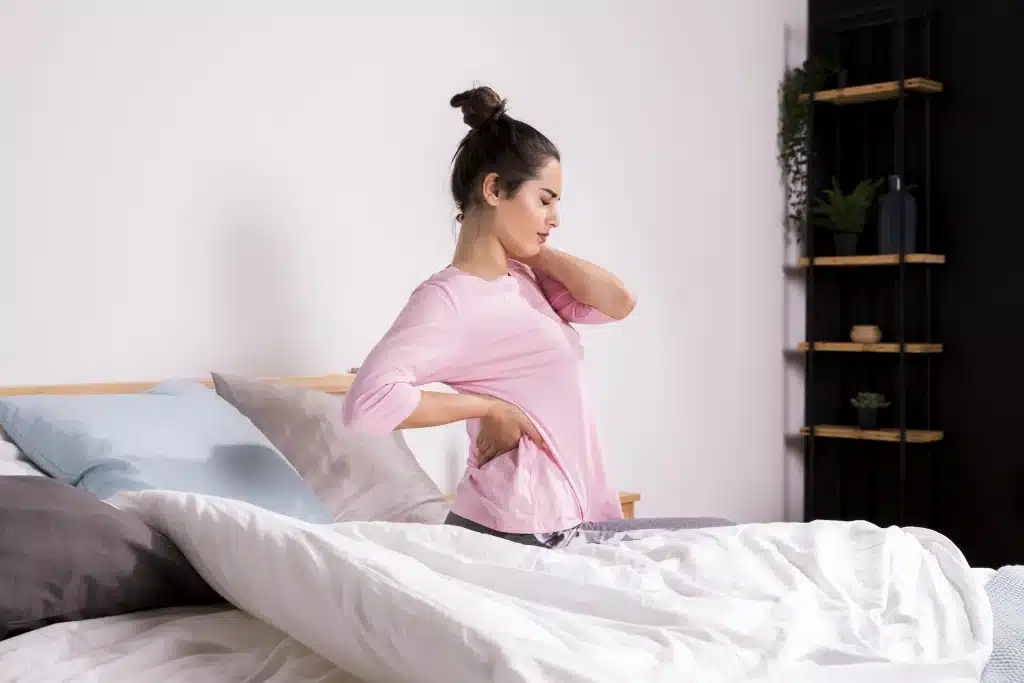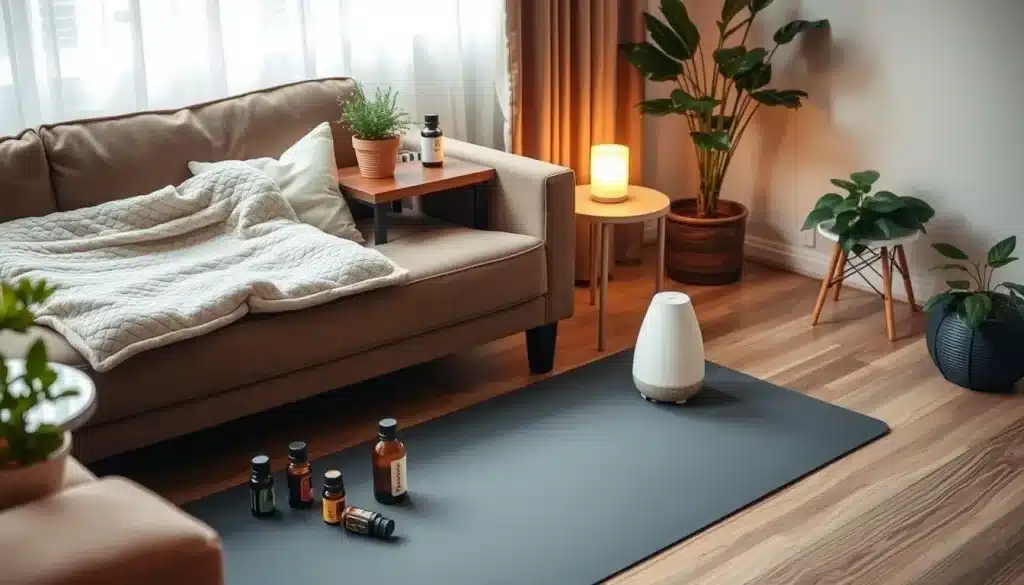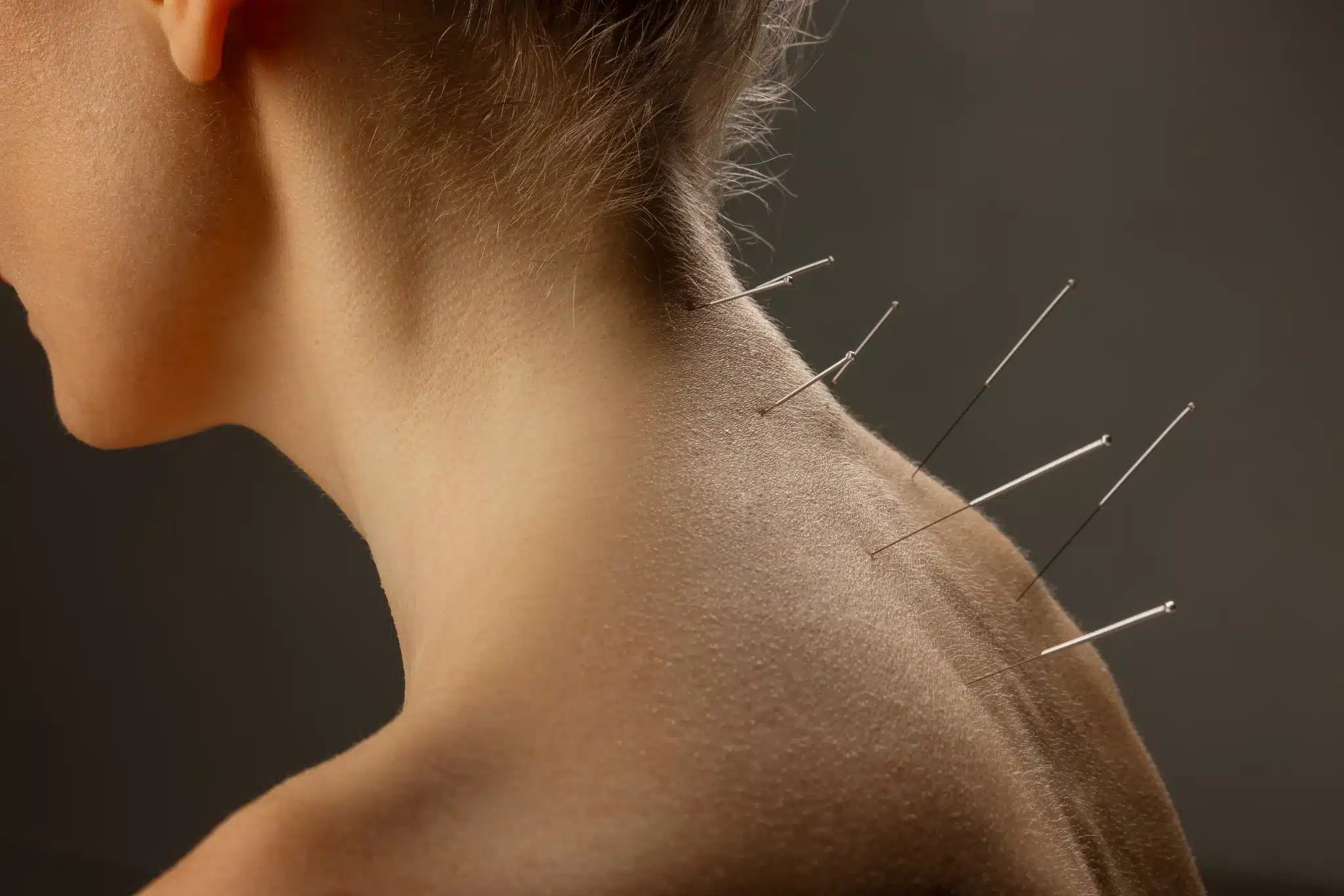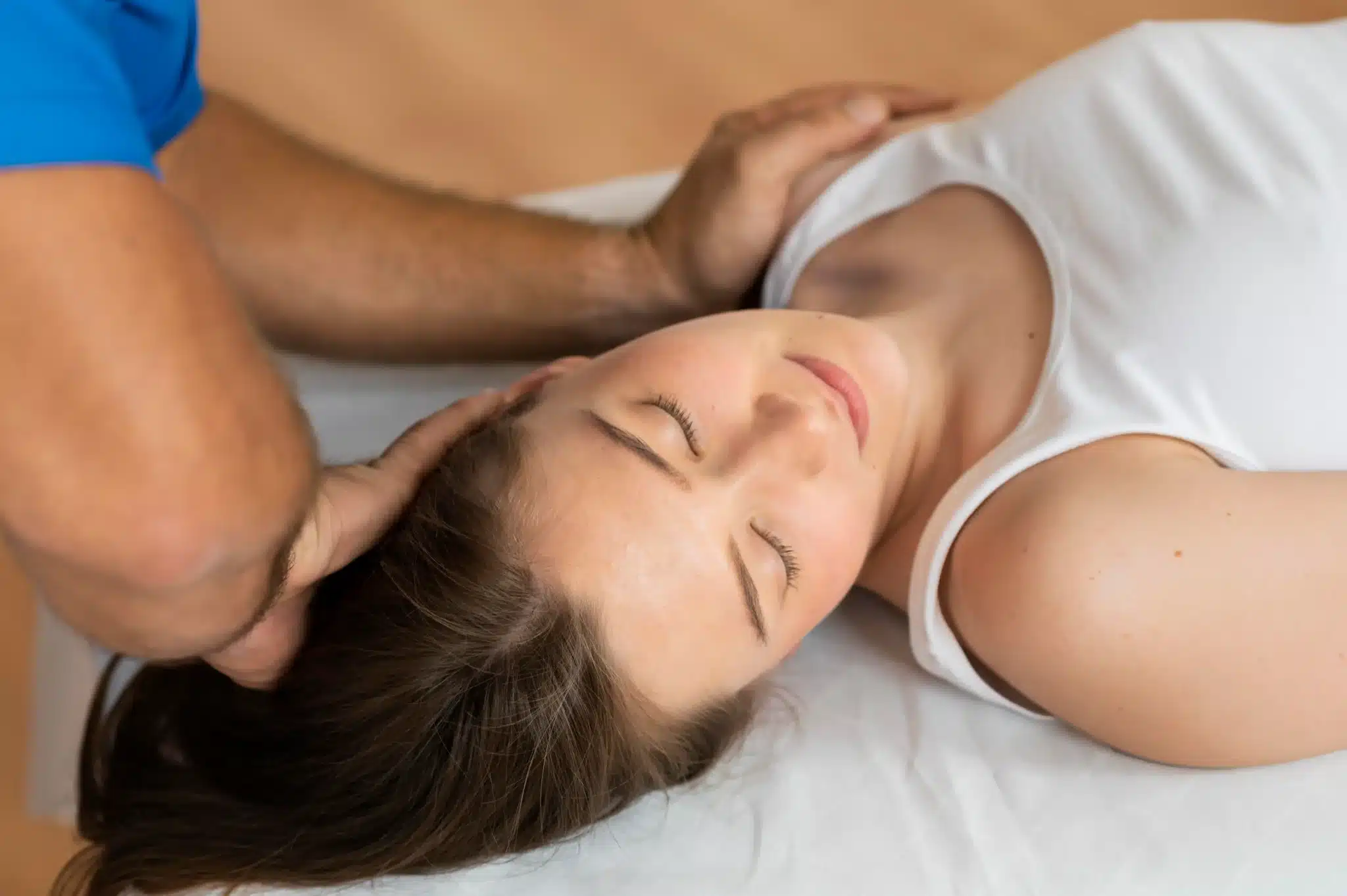Looking to turn back pain off without relying on medication? Back pain impacts millions globally, making it essential to explore natural, effective ways to manage discomfort. This guide offers insights into using holistic methods to alleviate—and potentially stop—back pain.
By understanding the root causes of back pain, implementing home remedies, and making strategic lifestyle changes, you can transform your approach to back care and find lasting relief.

A serene landscape featuring a peaceful outdoor scene with a person practicing yoga on a grassy hill, surrounded by lush trees and gentle mountains in the background; soft sunlight filtering through the leaves, highlighting natural elements like smooth stones and colorful wildflowers, evoking a sense of tranquility and holistic healing for back pain relief.
Key Takeaways
- Lower back pain is a leading cause of disability worldwide.
- Exercise regimens such as yoga, Pilates, and Tai Chi can significantly improve posture and reduce lower back pain.
- Most adults need 7 or more hours of quality sleep to help reduce the risk of chronic back pain.
- A healthy diet rich in whole grains, dairy, and fruits can potentially reduce chronic spinal pain.
- Stress management techniques like mindfulness meditation are crucial for reducing lower back pain.
Understanding Back Pain and Its Common Causes
Back pain is a big health problem worldwide. It costs a lot of money, makes people less productive, and lowers their quality of life. We'll look at why back pain happens, focusing on the lower back, vertebrogenic pain, and how muscles and the spine work.
Causes of Lower Back Pain
Lower back pain has many causes. These can be structural problems, repetitive strain, or poor posture. The lower back pain differential diagnosis approach points to pinched nerves, herniated disks, and injuries as common causes. Also, bad posture can make pain worse.

A human figure standing against a backdrop of anatomical diagrams highlighting the lumbar spine, with various indicators for different types of lower back pain, such as muscle strain, herniated disc, and sciatica, illustrated through color coding and visual symbols, emphasizing the complexity of lower back pain diagnosis without text or characters.
Vertebrogenic Pain and Related Conditions
Vertebrogenic back pain, or vertebrogenic low back pain icd 10, comes from vertebral problems like fractures or degenerative changes. It's common in older adults but can happen to anyone with spinal injuries or chronic stress. Smoking also plays a role because it affects blood flow and bone health.
Back Muscles and Spine Functionality
The back muscles and spine are key to understanding back pain. The spine has 24 vertebrae, important for structure and movement. Straining these muscles from heavy lifting or sitting too long can cause pain. The back pain location chart meaning helps find where the pain comes from, like muscle spasms or inflamed ligaments.
Here's a quick summary of what causes back pain:
| Factor | Details |
|---|---|
| Structural Problems | Herniated disks, pinched nerves, fractures |
| Repetitive Strain | Poor posture, repetitive movements, heavy lifting |
| Lifestyle Choices | Smoking, excess body weight, lack of exercise |
| Medical Conditions | Osteoarthritis, osteoporosis, vertebrogenic disorders |
| Injuries | Sports injuries, accidents, falls |
Keeping a balanced routine with exercise, proper lifting, and a healthy lifestyle can help prevent back pain. Understanding lower back pain and spine health is key to managing and preventing it.
Home Remedies to Relieve Back Pain
Home remedies can help a lot with back pain. This is especially true if standing up straight hurts or if you have pain after squats. Here are some easy ways to help your back feel better from home.

A cozy living room scene showcasing various home remedies for back pain relief, including a heating pad on a couch, herbal teas on a side table, essential oils with an oil diffuser, a yoga mat laid out on the floor, and a potted plant in the corner, soft lighting creating a warm and inviting atmosphere.
Effective Exercises and Stretches
Adding stretching exercises to your day is key for back pain. Studies show that exercises like the Back Flex and Bird Dog can lessen pain and improve flexibility. Stretching is especially good when your lower back hurts.
- Back Flex: Hold for 20-30 seconds, repeat 5-10 times.
- Knee to Chest Stretch: Hold for 20-30 seconds, repeat 5-10 times.
- Bird Dog: Hold each side for 10 seconds, aim for 10 repetitions.
These exercises not only help you move better but also prevent injuries.
Heat and Cold Therapy
Heat and cold therapy are simple ways to ease back pain. Ice is best for sudden pain like sciatica or muscle soreness after working out. Heat patches, like Voltarol Drug-Free Heat Patch, can give heat relief for up to 8 hours. These methods can help when standing up straight is painful.
Massage and Acupuncture
Massage can help relax back muscles. Acupuncture also helps by stimulating certain body points. Both can be used together; the National Center for Biotechnology Information (NCBI) says foam rollers are good for self-massage and back pain.
Pain-Relief Creams and Arnica
Pain-relief creams with menthol or capsaicin can give quick relief. Arnica is a natural option with anti-inflammatory properties. These can help with pain after squats without using drugs.
In summary, exercises, good posture, and home remedies can greatly reduce back pain. For more tips on managing back pain and finding drug-free options, check out Chiropractic Medicare Coverage Modernization Act.
Preventative Measures to Keep Back Pain Off
Preventing back pain is better than treating it. Simple daily habits can protect your spine and keep you feeling good. These habits help avoid back pain.
Posture Tips for Daily Activities
Good posture is key for a healthy spine. Sit with your knees higher than your hips and use a supportive chair. This helps avoid back strain.
When sleeping, use a pillow under your knees. It cuts pressure in half. Doing back and abdominal exercises twice a week also lowers injury risk. Learn more about preventing injuries here.
Proper Footwear and Orthotics
Wearing the right shoes is vital for back health, especially when standing. Opt for shoes with less than a 1-inch heel. This reduces back strain.
Orthotics can offer extra support if needed. Keeping a good balance and avoiding tight accessories also helps. These steps support anti-inflammatory back care.
Healthy Diet and Anti-Inflammatory Foods
Eating well is crucial for back health. Foods rich in calcium and vitamin D keep bones strong. This prevents osteoporosis.
Adding anti-inflammatory foods like fatty fish, leafy greens, and berries supports your spine. These foods help manage and prevent m54.51, or lower back pain.
By making these habits part of your daily life, you can reduce back pain. For more tips on back care, see these back pain relief guidelines.
Lifestyle Adjustments for Long-Term Relief
Managing back pain long-term means making lasting lifestyle changes. Chronic back pain, lasting over three months, needs a holistic approach. This includes stress management, ergonomic workspace setup, and quality sleep.
Stress Management Techniques
Stress can make back pain worse. So, managing stress is key to recovery. Relaxation exercises, mindfulness, and biofeedback therapy can help. Yoga and meditation also reduce muscle tension and pain.
Setting Up an Ergonomic Workspace
Creating an ergonomic workspace is a good start. Use ergonomic chairs, adjustable desks, and monitor stands. This ensures good posture and less strain. Proper posture helps avoid chronic pain.
Importance of Quality Sleep
Good sleep is crucial for back pain relief. It helps your body heal and recover. Choose a mattress and pillows that support your spine.
Try sleeping on your side with a pillow between your knees. A consistent sleep routine, free from distractions, improves recovery. These habits can greatly reduce back pain.
FAQ
What are some natural remedies for back pain relief?
Natural remedies include exercises and stretches, heat and cold therapy, and massage. Acupuncture, pain-relief creams, and arnica also help. These methods offer temporary relief from back pain symptoms.
What are the common causes of lower back pain?
Lower back pain often comes from muscle strain, poor posture, and spine issues. Daily habits can also cause it. Knowing the cause is key to treating and preventing back pain.
How can vertebrogenic pain affect my lower back?
Vertebrogenic pain comes from the vertebrae and can hurt your lower back a lot. It's a type of pain that can be diagnosed and treated.
What role do back muscles and spine functionality play in back pain?
Back muscles and spine are vital for posture and movement. If they don't work right, you might feel pain. Keeping them strong is important for comfort.
What exercises are effective for relieving back pain?
Stretching, core strengthening, and yoga can help with back pain. They make your back more flexible and less tense.
How does heat and cold therapy help with back pain?
Heat therapy relaxes muscles and boosts blood flow, easing stiffness and pain. Cold therapy numbs pain and cuts down inflammation, helping with acute pain.
Can massage and acupuncture help with back pain?
Yes, massage and acupuncture can help by easing muscle tension and improving blood flow. This reduces back pain symptoms.
Are pain-relief creams and arnica effective in treating back pain?
Pain-relief creams and arnica can give quick relief from back pain. They target specific pain spots and lessen discomfort.
How can I improve my posture during daily activities?
To better your posture, stay upright and avoid slouching. Make sure your work area is set up right. These steps can stop back pain.
What is the importance of proper footwear and orthotics in preventing back pain?
Good shoes and orthotics keep your back aligned and reduce strain. This is especially important if you're on your feet a lot.
What role does a healthy diet play in back pain prevention?
Eating well, especially anti-inflammatory foods, helps your spine stay healthy. It can lower the risk and severity of back pain by reducing inflammation.
What stress management techniques can help reduce back pain?
Stress-reducing activities like mindfulness, relaxation, and yoga can help. They ease tension and improve overall health, which can lessen back pain.
How can I create an ergonomic workspace to avoid back strain?
For an ergonomic workspace, adjust your chair and desk for good posture. Use supportive seating and keep your computer screen at eye level. This reduces back strain.
Why is quality sleep important for managing back pain?
Good sleep is key for back health as it lets your body repair and recover. Better sleep hygiene and a supportive sleeping position can lessen back pain and boost well-being.





